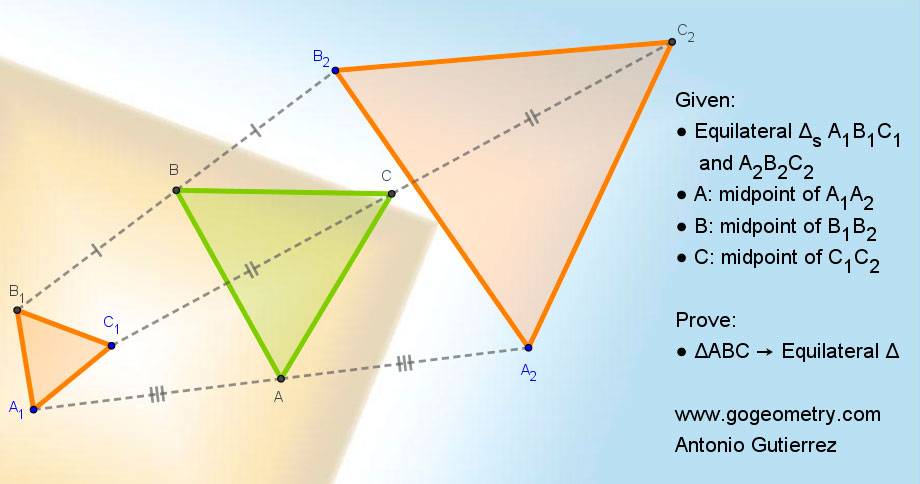Challenging Geometry Puzzle: Problem 1558. Share your solution by posting it in the comment box provided.
Audience: Mathematics Education - K-12 Schools, Honors Geometry, and College Level.
Gain comprehensive insights! Click below to reveal the complete details.
Click for additional details.
Share your solution by clicking 'Comment' below the post or entering your solution or comment in the 'Enter Comment' field and pressing 'Publish'.
Share your solution by clicking 'Comment' below the post or entering your solution or comment in the 'Enter Comment' field and pressing 'Publish'.
Perpendiculars from C1, C and C2 to B1B2 (extended to R) meet B1B2 at P, Q and R respectively.
ReplyDeleteLet C1B1= a and CB2 = b.
Let B1P = t1, PB = t2, BQ = t3, QB2 = t4 and B2R = t5.
Let C1P = u and C2R = v
C1PRC2 is a trapezoid with C1P//CQ//C2R, so by connecting C2P and applying the midpoint theorem,
CQ = (u+v)/2 ..........(1) and
t2 + t3 = t4 + t5 ......(2)
Now it is given that t1 + t2 = t3 + t4....... (3)
From (2) and (3), t3 = (t1 + t5) / 2..........(4)
Now consider Right Triangles B1C1P, BCQ and B2C2R
CQ = (u + v)/2
BQ = t3 = (t1+ t5)/2
and the included angle is 90
So BC = (a + b)/2
Similarly we can show that CA = (a+b)/2 and AB = (a+b)/2
Therefore Triangle ABC has BC = CA = AB and is thus equilateral
Sumith Peiris
Moratuwa
Sri Lanka
This is not true if A1B1C1 and A2B2C2 have opposite orientations.
ReplyDeleteExtend A2B to C3 so that A2B=BC3. Then B1C3=A2B2 and AB=A1C3/2. In the same way, B2C=CA3 and C2A=AB3. Triangle A2B3C3 is equilateral, so is ABC.
ReplyDeleteI do not undertand why BC=(a+b)/2
ReplyDeleteIf A1B1 is parallel to and has the same orientation with A2B2, then BC=(a+b)/2. But then the problem is trivial. For the general case see previous comment.
DeleteIt is possible to solve this problem using complex numbers. Label the points A1 as ZA1 (A1 as complex vector), A2 as ZA2, and so on. By the figure and the hypothesis that A1B1C1 and A2B2C2 form equilateral triangles, we find,
ReplyDelete(ZC1- ZA1)*cis 60º = ZB1 - ZA1, and (ZC2 - ZA2)*cis 60º = ZB2 - ZA2. Summing term by term these equations and dividing both by 2, we have:
((ZC1 + ZC2)/2 - (ZA1 + ZA2)/2)*cis 60º = (ZB1 + ZB2)/2 - (ZA1 + ZA2)/2 (1)
But, (ZC1 + ZC2)/2 = ZC, (ZA1 + ZA2)/2 = ZA and (ZB1 + ZB2)/2 = ZB, replacing in (1) we get,
(ZC - ZA)*cis 60º = ZB - ZA, which means that ABC forms an equilateral triangle.
Observe that this solution depends exactly on the orientations of the triangles A1B1C1 and A2B2C2, reinforcing the comment of Mr. César Eliud.
Joaquim Maia
Rio de Janeiro
Brazil